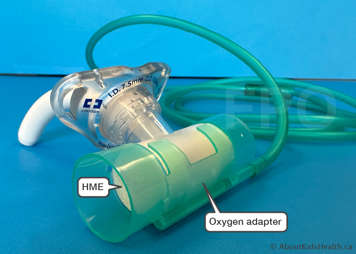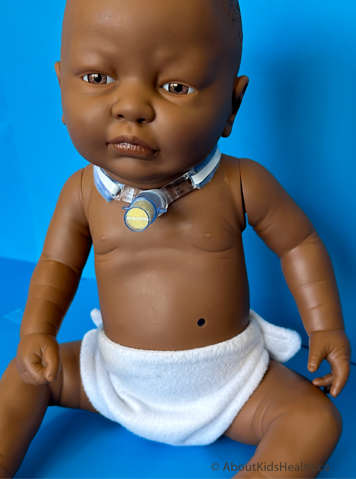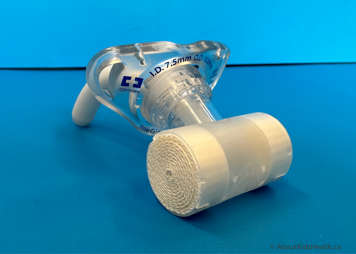
At the end of this chapter, you will be able to:
- describe how a heat and moisture exchanger (HME) works and how to maintain it.
A heat and moisture exchanger (HME) is a filter-like sponge that attaches to the end of tracheostomy tube to provide humidification and keep secretions thin while your child is awake.
HMEs are also known by several other terms including thermal humidifying filters, Swedish nose, artificial nose and tracheostomy filter.
How does an HME work?
When your child breathes out, the HME traps the heat and moisture from their breath. With the next breath in, the air passes through the HME and becomes warm and moist.
An HME, although not specified as a filter, is sometimes called an artificial nose because it also acts as a filter and can prevent small particles from entering the trachea.
Some HME’s are combined with a microbiological filter, hence they are called HME filters (HMEF).

It can be used with or without oxygen. If your child needs oxygen as well as an HME, they may have one of the following setups:
-

An oxygen adaptor that attaches on top of the HME. This is brand specific and not all brands offer this extra attachment.
-

Tracheostomy venturi mask. This is a tracheostomy mask with a venturi device attached to it. The venturi device offers different oxygen settings. Use the setting for the amount of oxygen prescribed. Some venturi setups come in color coded options where each colour represents an amount of oxygen and also tells you how much flow to use. The other option is an all-in-one venturi device where you rotate the venturi to select the amount of oxygen you need.
Points to note about an HME
- An HME provides less humidification than other devices, so suctioning may be needed more often.
- Transitioning to an HME can make it harder for some children to breathe. Building from short time periods to longer time periods of using the HME can help. Work with your child’s health-care team to know how to manage the tracheostomy with an HME in place.
Consider avoiding HME use:
- If your child has a lot of secretions because their secretions can plug the HME filter. This can lead to your child working harder to breathe.
- When your child is sleeping for the following reasons:
- During sleep, respiratory muscles do not function the same way they do while awake. The effort it takes to breathe through an HME that provides added resistance is decreased. Therefore, your child may not inhale or exhale with enough force to breathe through the HME. This can also lead to increased work to breathe, lower oxygen saturations and higher carbon dioxide numbers.
- If your child needs humidified air when sleeping, they should be on a humidification system that provides more humidity like a tracheostomy mask or a heated high flow system.
Talk to your health-care team about whether an HME is right for your child. You can also refer to the manufacturer’s guidelines as some mention minimum weight or breathing volume requirements.
HME types and sizes
HMEs come in many different types and sizes. For children using ventilators, specific HME’s are placed along the ventilator tubing. Your health-care team will tell you which one is right for your child. The following are examples of different HMEs:

A GE HCH/BREATHE EASY HME, for children who weigh less than 5 kilograms (11 lbs)

A tracheostomy-vent HME, for children who weigh more than 5 kilograms (11lbs)

An inline HME for use with a ventilator
How often should I change my child's HME?
Change the HME:
- every day, if your child is using the HME throughout the day
- as soon as possible, if it gets excessively moist or soiled
- as soon as possible, if it gets plugged with mucus
Precaution
Do not wet the HME prior to use. Do not let water come into contact with the HME because it can create added resistance, making it more difficult for your child to breathe.
